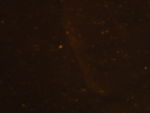Bryan Hernandez/20.109/Lab notebook/Module 4/Day 2: Difference between revisions
(New page: --~~~~ '''purpose:''' to try and optimize the protocol for finding gold binders from the first days experiment. also to prepare galactose culture tubes for tomorrow's lab. ==Protocol== ...) |
No edit summary |
||
| Line 1: | Line 1: | ||
==Optimizing Gold Binding Yeast Screen Protocol== | |||
--[[User:Bryanh|Bryanh]] 16:32, 2 May 2007 (EDT) | --[[User:Bryanh|Bryanh]] 16:32, 2 May 2007 (EDT) | ||
| Line 5: | Line 9: | ||
==Protocol== | ==Protocol== | ||
===Part 1: Optimizing panning conditions=== | ===Part 1: Optimizing panning conditions=== | ||
The only | '''expt1:''' This was identical to Day 1's procedure to screen for gold binders comparing PCT-CON to pAu1. The only difference in this protocol was that instead of incubating the gold sheet in blocking buffer at room temperature and on a rocker that only moved in a circular motion we incubated it in a 30C incubator on a rocker that moved around in circles. This change in protocol is aimed to reduce the number of bacteria that we see on out - control plate, that being PCT-CON by better blocking the Au surface. | ||
'''Expt2:'''Also identical to the Day 1 protocol for screening yeast gold binders comparing PST-CON to pAu1. The only difference to this protocol was that we increased the time that we allowed the blocking buffer wash the surface of the gold before we added the yeast. this would hopefully improve our negative control results as well by keeping non-specific binders from binding to the gold plate and resulting in high colony counts on our PCT-CON plate. | |||
===Part 2: Library rescreen=== | ===Part 2: Library rescreen=== | ||
| Line 18: | Line 22: | ||
===Part 3: Research proposal=== | ===Part 3: Research proposal=== | ||
discussed mad research ideas... | |||
| Line 43: | Line 34: | ||
[[Image: Exp2 pAu1.jpg|150px|Expt2 pAu1]] | [[Image: Exp2 pAu1.jpg|150px|Expt2 pAu1]] | ||
results of both experiments are shown. in order the pictures are the pre-incubation results of: Expt1 PTC-CON, Expt1 pAu1, Expt2 PTC-CON, Expt2 pAu1. | |||
It appears as though Expt2 was better at reducing non-specific gold binding. | |||
Latest revision as of 13:58, 2 May 2007
Optimizing Gold Binding Yeast Screen Protocol
--Bryanh 16:32, 2 May 2007 (EDT)
purpose: to try and optimize the protocol for finding gold binders from the first days experiment. also to prepare galactose culture tubes for tomorrow's lab.
Protocol
Part 1: Optimizing panning conditions
expt1: This was identical to Day 1's procedure to screen for gold binders comparing PCT-CON to pAu1. The only difference in this protocol was that instead of incubating the gold sheet in blocking buffer at room temperature and on a rocker that only moved in a circular motion we incubated it in a 30C incubator on a rocker that moved around in circles. This change in protocol is aimed to reduce the number of bacteria that we see on out - control plate, that being PCT-CON by better blocking the Au surface.
Expt2:Also identical to the Day 1 protocol for screening yeast gold binders comparing PST-CON to pAu1. The only difference to this protocol was that we increased the time that we allowed the blocking buffer wash the surface of the gold before we added the yeast. this would hopefully improve our negative control results as well by keeping non-specific binders from binding to the gold plate and resulting in high colony counts on our PCT-CON plate.
Part 2: Library rescreen
Examine the Petri dishes that you spread last time. Count the number of colonies on each plate and enter your data in the table on the discussion page for this lab. It is OK to count only 1/2 or 1/4 or 1/8 of the colonies if they are densely growing. In these cases, try to find a representative sector to count and don’t forget to multiply for the total number of colonies on the plate. Circle four colonies that are nicely isolated from others on the "library" petri dish. Label those colonies "A" "B" "C" or "D".
Next you should set up four tubes with 2.5 ml of glucose-containing media and four tubes with 5 ml of galactose-containing media. Use colored dots to label the tops of each “A” “B” “C” or “D.” Use sterile technique since these will be used to grow any gold binding candidates for next time.
Finally use a sterile dowel to transfer some of the correct colony from your petri dish to the glucose-containing media, and balance the tubes on the roller wheel in the 30° incubator. Give the galactose-containing media to the teaching faculty who will innoculate them before next lab.You should also return to the teaching faculty the petri dish from the library screen so it can be stored until next time.
Part 3: Research proposal
discussed mad research ideas...
summary/interpretation
results of both experiments are shown. in order the pictures are the pre-incubation results of: Expt1 PTC-CON, Expt1 pAu1, Expt2 PTC-CON, Expt2 pAu1.
It appears as though Expt2 was better at reducing non-specific gold binding.



